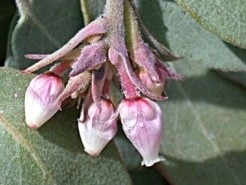Hoary manzanita
(Arctostaphylos canescens)

Description
Arctostaphylos canescens, common name hoary manzanita, is a species of manzanita. Arctostaphylos canescens is native to the coastal mountain ranges of southwestern Oregon and northern California, where it grows in forest and chaparral plant communities. The Arctostaphylos canescens is a shrub varying in shape from short and matted to spreading up to 2 meters (6.6 ft) in height. Smaller branches and twigs are hairy to woolly. The smooth-edged leaves are oval in shape and pointed at the tip, woolly to rough and waxy, and up to 5 centimeters long. The plant blooms in dense inflorescences of whitish, urn-shaped manzanita flowers which are woolly inside. The fruit is a hairy drupe 0.5 to 1 centimeter wide. Arctostaphylos is a genus of plants comprising the manzanitas and bearberries. They are shrubs or small trees. There are about 60 species, of Arctostaphylos, ranging from ground-hugging arctic, coastal, and mountain species to small trees up to 6 m tall. Most are evergreen (one species deciduous), with small oval leaves 1–7 cm long, arranged spirally on the stems. The flowers are bell-shaped, white or pale pink, and borne in small clusters of 2–20 together; flowering is in the spring. The fruit are small berries, ripening in the summer or autumn. The berries of some species are edible. Arctostaphylos species are used as food plants by the larvae of some Lepidoptera species including Coleophora arctostaphyli (which feeds exclusively on A. uva-ursi) and Coleophora glaucella. Manzanitas, the bulk of Arctostaphylos species, are present in the chaparral biome of western North America, where they occur from southern British Columbia in Canada, Washington to California and New Mexico in the United States, and throughout much of northern and central Mexico. Three species, the bearberries, A. alpina (alpine bearberry), A. rubra (red bearberry) and A. uva-ursi (common bearberry), have adapted to arctic and subarctic climates, and have a circumpolar distribution in northern North America, Asia and Europe. An unusual association of manzanita occurs on Hood Mountain, in Sonoma County, California, where stands of pygmy forest dominated by Mendocino cypress are found.
Taxonomic tree:







